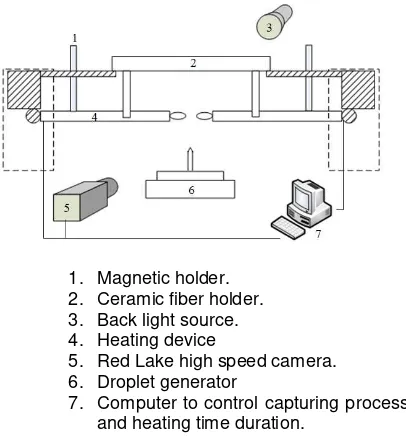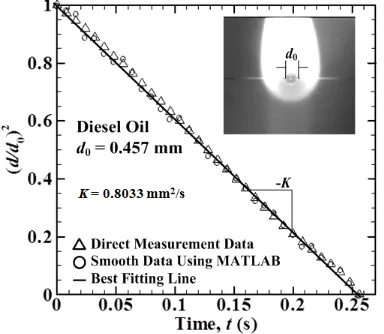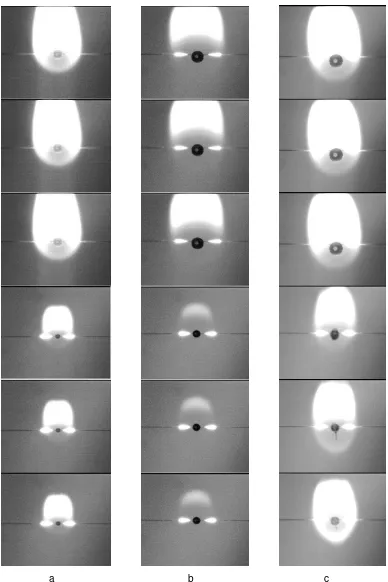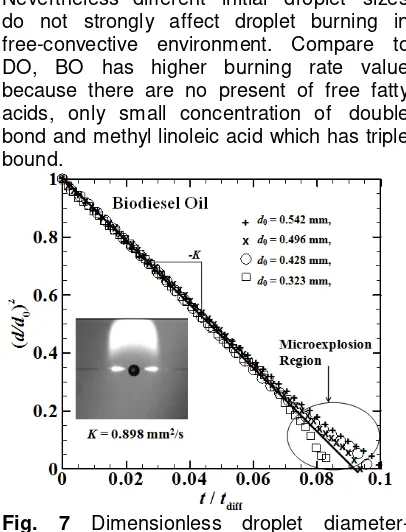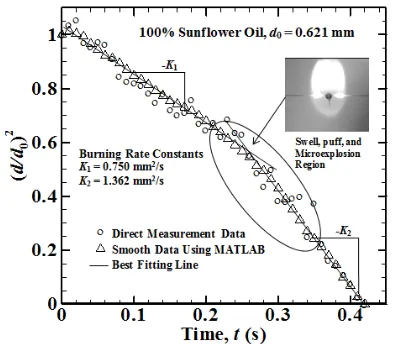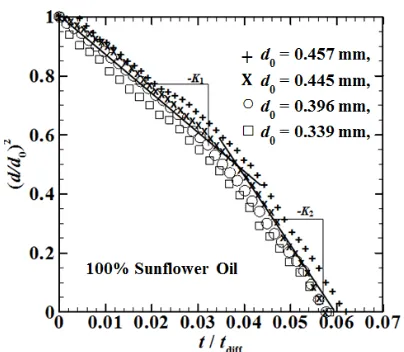59
Burning Rate Constants and Microexplosion Phenomena
Measurements of Droplet Combustion
Basthiyan Sidqi Fidari Rosyadi1,2, I Nyoman Gede Wardana2,
Shenqyang (Steven) Shy1
1Department of Mechanical Engineering, National Central University 2Department of Mechanical Engineering, Brawijaya University
Email: [email protected]
Abstract
This study investigates experimentally droplet combustion in a quiescent atmosphere using diesel oil (DO), biodiesel oil (BO), and sunflower oil (SO). Symmetrically spherical droplets with diameters varying from 0.3 mm to 0.6 mm are generated by a home-built piezoelectrically-driven droplet generator. Before a run, the small droplet is suspended at the intersection of two very fine horizontally-positioned, perpendicularly-aligned ceramic fibers of 20 µm in diameter. A run begins at a time when a diffusional flame is just established to envelop the suspended droplet using an electrically-controlled and automatically-removed heating device. A high-speed camcorder is used to record the time evolution of droplet burning process. Results show that after flame envelope the droplet where initial diameter (d0) is determined, DO and BO droplet instantaneous diameters (d) just shrink with increasing time, where plot for d2 -law give linear slope indicate that DO and BO can be assumed as single-component fuel with burning rate constants value, but SO which is multi-component fuels, give two kinds slope from d2-law plot indicate that there are two value burning rate constants, namely K1 for first stage of burning rate constant and K2 for second stage of burning rate constant.
Keywords: Droplet combustion, Burning Rate Constant, Microexplosion.
INTRODUCTION
Nowadays, fossil fuel is still mostly favoured among many other sources of energy in the world. It is widely used as source of energy for transportation and machinery due to its high heating power, massive availability and good quality of combustion characteristic.
Unfortunately, the combustion of fossil fuel also takes the main part as contributor to the increase in the level of CO2 in the atmosphere. The increase gas volume of CO2 causes greenhouse effect that absorbs certain wave lengths of infrared radiation emitted from earth instead of radiated it out to space. It is directly associated with temperature increase which is called global warming. One of their main concerns is the development of biofuel as fuel source alternative. Many studies have pointed out that biofuel can help reduce emissions of carbon particulates and other harmful
60
by [2-5] resulting heating value of biodiesel is greater than bio-diesel.Compared to diesel oil, biodiesel has burning rate constant value greater than diesel oil. This occurs due to the evaporation rate of biodiesel which has a greater value than evaporation rate of diesel oil. Sunflower oil (SO) which is one of vegetable oils where the main composition is polyunsaturated fatty acids, can be assumed as multicomponent fuel because it contains many types of fatty acid. In case of vegetable oil at low elevated temperature by analyse the temperature changes, and microexplosion phenomenon takes place just before the second stage combustion. These microexplosion phenomena lead to oscillation that makes evaporation rate constant hard to calculate [7]. Multicomponent droplet combustion becomes more complex because there are bubble formations, which eventually lead to a rupture in the droplet and microexplosion phenomena [8-11].
EXPERIMENTAL APPARATUS AND METHOD
Droplet experimental consisted of ceramic fiber, droplet generator, high speed camera, and heating system, as shown in Fig. 1. Droplet generated use piezoelectric generator that produce droplet with
7. Computer to control capturing process and heating time duration. natural convection are neglected. This reduces the analysis to one dimension. 2. The droplet is an isolated one conductivity, density, and specific heat
are constant, Lewis number is unity. 5. The chemical reaction rate is much temperature, with no heating phenomenon
61
0
at equilibrium. Therefore fuel vapor that produce which is at its saturation vapor pressure corresponding to the droplet surface temperature.
11. Ignore Soret, dufour, and radiation effects.
From these assumptions, by the governing equations and boundary conditions derived d2-Law, as follow
d2 = d2 – K t
This is the d2-law of droplet vaporization where d0 is the initial droplet diameter, d is instantaneous droplet diameter, and t is time. This indicates that during this combustion process square of the droplet diameter decrease constant with the reduced time.
RESULTS AND DISCUSSION
Diesel oil
Droplet combustion of DO gives linear slope from d2-law plot. Droplet only shrinking with changing of times indicates that it can be assume as a single component fuels. In Fig. 2 show that direct measurements of droplet instantaneous diameter for d2-law plot give small oscillations due to buoyancy effect, where MATLAB used to get best fitting line to calculate burning rate constant value with d 0.457 mm. From this d2-law slope burning rate constant value can be obtained, for d0 = 0.457 mm, 0.445 mm, 0.396 mm,
and 0.339 mm, burning rate constant (K) value are 0.8033 mm2/s, 0.8180 mm2/s,
0.8255 mm2/s, and 0.8284 mm2/s
respectively, shown in Fig. 3
Fig. 2 A typical case showing the determination of the burning rate constant by the d2-law.
The inset is an instantaneous image of diesel oil droplet enveloped by its flame just after the removal of ignition heating wires. With increasing d0 burning rate value will
decrease, due to diffusion process takes longer time to make droplet completely evaporated. However different initial droplet sizes do not strongly affect droplet burning in free convective environment.
62
Fig. 4 Droplet combustion sequences for ( a) diesel oil (DO), (b) biodiesel oil (BO), and ( c ) sunflower oil (SO).
63
diff 0
Fig. 5 Dimensionless droplet diameter- square versus time, normalize with time diffusion for diesel oil, where t = d2/α and α is thermal diffusivity of commercial diesel oil.
Droplet combustion sequences for DO, BO, and SO are shown in Fig. 4. Where DO have more bright color compare to BO and SO indicate that a lot of soot generated at combustion product. And Physical properties comparison for diesel, biodiesel and sunflowers oil showed at Table 1.
Table 1. Physical properties comparison for diesel and sunflowers oil from [13-16]
Properties Diesel Oil Biodiesel Oil Sunflower Oil
Density at 150C
(g/cm3) 0.82 0.881 0.860 - 0.918
Boiling point (0C) ~162 204 ~320
Flash point (0C) 52 177 274
Higher Heating
Value (MJ/kg) 44.8 39.4 33.5
Cetane Number 52 51.2 37
Thermal Diffusivity
(10-7m2/s) 0.715 0.843 0.57
By dividing time with diffusion time (tdiff), where diffusion time (tdiff) defined as
droplet initial diameter square (d2) divided thermal diffusivity (α) of diesel oil. The diameter- square plot can be collapse together, indicate that diffusion process plays an important role on droplet combustion, shown in Fig. 5. slope burning rate constants value can be obtained, for d0 =
0.542 mm, 0.496 mm, 0.428 mm, 0.323 mm burning rate constant (K) are 0.8851 mm2/s, 0.8911 mm2/s, 0.9028 mm2/s, and 0.9152 mm2/s respectively. By normalize time with diffusion time (tdiff), where diffusion time (tdiff)
defined as droplet initial diameter square (d2) divided thermal diffusivity (α) of biodiesel oil, the diameter-square plot.
Biodiesel oil
Biodiesel droplet combustion give linear slope like diesel oil from d2-law plot, indicate that it is can be assumed as single- component fuel with burning rate constants value. However there are small disturbance as it approached at the end of the
combustion process, due to small amount of double bond or more concentration in this biodiesel leading swell and puff at nearly end of the combustion process.
Fig. 6. Determination of the burning rate constants from diameter-square versus time for biodiesel oil with different initial diameters
64
diff 0
Nevertheless different initial droplet sizes do not strongly affect droplet burning in free-convective environment. Compare to DO, BO has higher burning rate value because there are no present of free fatty acids, only small concentration of double bond and methyl linoleic acid which has triple bound.
Fig. 7 Dimensionless droplet diameter- square versus time, normalize with time oscillation from direct measurement data shown in Fig. 8. Fats and oils are esters of the tri-alcohol, glycerol (or glycerin). Therefore, fats and oils are commonly called triglycerides and its make up the structure of sunflower oil. They are primarily composed of long chains of fatty acid esters. Triglyceride molecules contain mostly carbon and hydrogen atoms. They are similar to the hydrocarbons in petroleum. The properties of triglycerides depend on the fatty acid composition and relative location of fatty acids on the glycerol, so that sunflower oil called multi- component fuel. Fatty acids contain an even number of carbon atoms, from 4 to 36, bonded in an unbranched chain.
Table 2. Fatty acids in Sunflower oil.
Fatty Acid wt % Structure Formula Boiling Point (0C) of atoms attached to each carbon atom is the maximum of four. If some of the bonds between carbon atoms are double bonds, then the fatty acid is unsaturated. When burned unsaturated fatty acids give higher value compare to the saturated fatty acids. droplet combustion. During heating process
65
When glycerin breaks from fatty acid, glycerin can rapidly absorb water even at room temperature. W ater that absorb by glycerin evaporated together with low level of volatile component begin to evaporate. Water bubble and low level of volatile component move inside droplet not only because the buoyancy but also ceramic fiber effect. When bubble reach the surface of the droplet, it break up droplet surface and ejecting amount fuel including vapor of low level volatile component, that burn quickly called microexplosion. This phenomena lead to second stage burning rate constant has higher value than first stage burning rate constant (K2>K1). Theinitial droplet diameter (d0) for pure sunflower
oil case is 0.621 mm, 0.592 mm, 0.533 mm, 0.459 mm, and 0.408 mm, In Fig. 9 show increasing droplet initial diameter first stage burning rate constant (K1) decrease, this is
refer to diesel oil where diffusion process takes longer time to make droplet evaporate completely. But for second stage of burning rate constants increasing droplet initial diameter will increasing burning rate constants value due to increasing low volatile component inside the droplet lead to swell, puff, and microexplosion rapidly occurs.
Fig. 8. Determination of the burning rate constant from direct measurement and smooth data using MATLAB of d2-law for sunflower oil case at d0 = 0.621 mm
Fig. 9. Determination of the burning rate constants from diameter-square versus time for sunflower oil with different initial diameters.
MATLAB give best fitting line to calculate burning rate constant. Sunflower oil give two kinds of slope from d2-law plot, namely first stage burning rate constant (K1) and
second stage burning rate constant (K2),
where K2 value is greater than K1 due to
66
2
0
Fig. 10. Dimensionless droplet diameter- square versus time, normalize with time diffusion for diesel oil, where tdiff = d0 /α and α
is thermal diffusivity of commercial sunflower oil.
When glycerin breaks from fatty acid, glycerin can rapidly absorb water even at room temperature. W ater that absorb by glycerin evaporated together with low level of volatile component begin to evaporate. quickly called microexplosion. This phenomena lead to second stage burning rate constant has higher value than first stage burning rate constant (K2>K1). The initial
droplet diameter (d0) for pure sunflower oil
case is 0.621 mm, 0.592 mm, 0.533 mm, 0.459 mm, and 0.408 mm, In Fig.9 show increasing droplet initial diameter first stage burning rate constant (K1) decrease, this is
refer to diesel oil where diffusion process takes longer time to make droplet evaporate completely. But for second stage of burning rate constants increasing droplet initial diameter will increasing burning rate constants value due to increasing low volatile component inside the droplet lead to swell, puff, and microexplosion rapidly occurs.
Normalize of sunflower oil burning time by dividing time with diffusion time (tdiff), that
shown in Fig. 10, where diffusion time (tdiff)
defined as droplet initial diameter square (d 2) divided thermal diffusivity (α) of sunflower oil. The diameter-square plot nearly can be collapse together. Due to
oscillation from bubble motion and microexplosion phenomena, indicate that diffusion process still plays an important role on droplet combustion.
Conclusions
1. Diesel oil (DO) and biodiesel oil (BO) droplet combustion give single linear slope from d2-law plot indicated these oils can be assuming as a single component fuel. 2. Biodiesel oil has higher burning rate the well-known the hydrolysis process. When glycerine is formed it will absorb multi-component fuels, which has different volatility of free fatty acids component, "Synergistic combustion of droplets of ethanol, diesel and biodiesel mixtures", Fuel, Vol.94, 342–347.
[3] Pan, K.L, and Chiu, M.C., 2013,
“Droplet combustion of blended fuels with alcohol and biodiesel/diesel in microgravity condition”, Fuel, Vol.113, 757–765.
[4] Zhu, M., Ma, Y., and Zhang, D., 2013,
67
[5] Li, T.X., Zhu, D.L., Akafuah, N.K.,Saito, K., and Law, C.K., 2011,
“Synthesis, droplet combustion, and sooting characteristics of biodiesel produced from waste vegetable oils”, Proceedings of the Combustion Institute, Vol.33, 2039–2046.
[6] Wardana, I.N.G., 2010,"Combustion characteristics of jatropha oil droplet at various oil temperatures", Fuel, Vol.89, 659–664.
[7] Daho, T., Vaitilingom, G., Sanogo, O., Ouiminga, S.K., Segda, B.G., Valette, J., Higelin, P., and Koulidiati, J., 2012,
“Study of droplet vaporization of various vegetable oils and blends of domestic fuel oil cottonseed oil under different ambient temperature conditions”, Biomass and Bioenergy, Vol.46, 653-66.
[8] Hou, S.S., Rizal F.M., Lin T.H., Yang T.Y., and Wan H.P., 2013, "Microexplosion and ignition of droplets of fuel oil/bio-oil (derived from lauan wood) blends", Fuel, Vol.113, 31– 42.
[9] Mishra, D.P., and Patyal, A., 2012, "Effects of initial droplet diameter and pressure on burning of ATF gel propellant", Fuel, Vol.95, 226-233. [10] Nam, H., and Alvarado, J.L., 2012,
